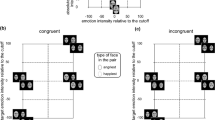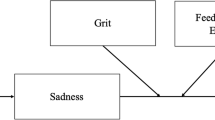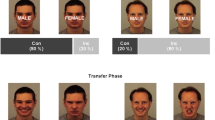Abstract
Three experiments tested the hypothesis of implicit associations between happiness and the performance ease concept and between sadness and the performance difficulty concept. All three studies applied a sequential priming paradigm: participants categorized emotion words (Experiment 1) or facial expressions (Experiment 2) as positive or negative or as referring to ease or difficulty (Experiment 3). These targets were preceded by briefly flashed ease- or difficulty-related words or neutral non-words (Experiments 1 and 2) or by happy, sad, or neutral facial expressions (Experiment 3) as primes. As predicted, all three experiments revealed increases in reaction times in the sequential priming task from congruent trials (happiness/ease and sadness/difficulty) over neutral trials to incongruent trials (sadness/ease and happiness/difficulty). The findings provide evidence for implicit associative links of happiness with ease and sadness with difficulty, as posited by the implicit-affect-primes-effort model (Gendolla, Int J Psychophysiol 86:123–135, 2012; Soc Pers Psychol Compass 9:606–619, 2015).



Similar content being viewed by others
Notes
French words that were originally used as ease-related prime words: léger, relax, congé, evident; difficulty-related prime words: dur, examen, effort, épreuve; positive target words: gaité, heureux, joyeux, agréable; negative target words: pénible, accablé, abattu, triste.
Given that we had directed hypotheses, the p values of the paired t tests are one-tailed.
French words that were originally used as ease-related prime words: aisé, evident, relax, simple; difficulty-related prime words: ardu, complexe, compliqué, éprouvant.
References
Blanchfield, A., Hardy, J., & Marcora, S. (2014). Non-conscious visual cues related to affect and action alter perception of effort and endurance performance. Frontiers in Human Neuroscience, 8, 967. doi:10.3389/fnhum.2014.0096.
Brehm, J. W., & Self, E. A. (1989). The intensity of motivation. Annual Review of Psychology, 40, 109–131. doi:10.1146/annurev.ps.40.020189.000545.
Carr, T. H., McCauley, C., Sperber, R. D., & Parmelee, C. M. (1982). Words, pictures, and priming: on semantic activation, conscious identification, and the automaticity of information processing. Journal of Experimental Psychology: Human Perception and Performance, 8, 757–777. doi:10.1037/0096-1523.8.6.757.
Chatelain, M., & Gendolla, G. H. E. (2015). Implicit fear and effort-related cardiac response. Biological Psychology, 111, 73–82. doi:10.1016/j.biopsycho.2015.08.009.
De Houwer, J., Teige-Mocigemba, S., Spruyt, A., & Moors, A. (2009). Implicit measures: a normative analysis and review. Psychological Bulletin, 135, 347–368. doi:10.1037/a0014211.
Dreisbach, G., & Fischer, R. (2012). Conflicts as aversive signals. Brain and Cognition, 78, 94–98. doi:10.1016/j.bandc.2011.12.003.
Fazio, R. H. (2001). On the automatic activation of associated evaluations: an overview. Cognition and Emotion, 15, 115–141. doi:10.1080/0269993004200024.
Freydefont, L., & Gendolla, G. H. E. (2012). Incentive moderates the impact of implicit anger versus sadness cues on effort-related cardiac response. Biological Psychology, 91(120), 127. doi:10.1016/j.biopsycho.2012.04.002.
Freydefont, L., Gendolla, G. H. E., & Silvestrini, N. (2012). Beyond valence: the differential effect of masked anger and sadness stimuli on effort-related cardiac response. Psychophysiology, 49, 665–671. doi:10.1111/j.1469-8986.2011.01340.x.
Gendolla, G. H. E. (2012). Implicit affect primes effort: a theory and research on cardiovascular response. International Journal of Psychophysiology, 86, 123–135. doi:10.1016/j.ijpsycho.2012.05.003.
Gendolla, G. H. E. (2015). Implicit affect primes effort: basic processes, moderators, and boundary conditions. Social and Personality Psychology Compass, 9, 606–619. doi:10.1111/spc3.12208.
Gendolla, G. H. E., & Silvestrini, N. (2011). Smiles make it easier and so do frowns: masked affective stimuli influence mental effort. Emotion, 11, 320–328. doi:10.1037/a0022593.
Gendolla, G. H. E., Wright, R. A., & Richter, M. (2012). Effort intensity: some insights from the cardiovascular system. In R. M. Ryan (Ed.), The Oxford handbook of human motivation (pp. 420–440). New York: Oxford University Press.
Kirita, T., & Endo, M. (1995). Between face advantage in recognizing facial expressions. Acta Psychologica, 89, 149–163. doi:10.1016/0001-6918(94)00021-8.
Klauer, K. C., & Musch, J. (2003). Affective priming: Findings and theories. In J. Musch & K. C. Klauer (Eds.), The psychology of evaluation: Affective processes in cognition and emotion (pp. 7–49). Mahwah: Lawrence Erlbaum Associates.
Kreibig, S. D., Gendolla, G. H. E., & Scherer, K. R. (2012). Goal relevance and goal conduciveness appraisals lead to differential autonomic reactivity in emotional responding to performance feedback. Biological Psychology, 91, 365–375. doi:10.1016/j.biopsycho.2012.08.007.
Langner, O., Dotsch, R., Bijlstra, G., Wigboldus, D. H. J., Hawk, S. T., & van Knippenberg, A. (2010). Presentation and validation of the Radboud Faces Database. Cognition and Emotion, 24, 1377–1388. doi:10.1080/02699930903485076.
Lasauskaite, R., Gendolla, G. H. E., & Silvestrini, N. (2013). Do sadness-primes make me work harder because they make me sad? Cognition and Emotion, 27, 158–165. doi:10.1080/02699931.2012.689756.
Lasauskaite Schüpbach, R., Gendolla, G. H. E., & Silvestrini, N. (2014). Contrasting the effects of suboptimally versus optimally presented affect primes on effort-related cardiac response. Motivation and Emotion, 38, 748–758. doi:10.1007/s11031-014-9438-x.
Leppänen, J. M., & Hietanen, J. K. (2003). Positive facial expressions are recognized faster than negative facial expressions, but why? Psychological Research, 69, 22–29. doi:10.1007/s00426-003-0157-2.
Leppänen, J. M., Tenhunen, M., & Hietanen, J. K. (2003). Faster choice-reaction times to positive than to negative facial expressions: the role of cognitive and motor processes. Journal of Psychophysiology, 17, 113–123. doi:10.1027//0269-8803.17.3.113.
Lundqvist, D., & Litton, J. E. (1998). The Averaged Karolinska Directed Emotional Faces—AKDEF. CD ROM from Department of Clinical Neuroscience, Psychology Section, Karolinska Institutet.
McShane, B. B., & Bockenholt, U. (2014). You cannot step into the same river twice: when power analyses are optimistic. Perspectives on Psychological Science, 9, 612–625. doi:10.1177/174569161454851.
Murphy, S. T., & Zajonc, R. B. (1993). Affect, cognition, and awareness: affective priming with optimal and suboptimal stimulus exposures. Journal of Personality and Social Psychology, 64, 723–739. doi:10.1037/0022-3514.64.5.723.
Neumann, R., & Lozo, L. (2012). Priming the activation of fear and disgust: evidence for semantic priming. Emotion, 12, 223–228. doi:10.1037/a0026500.
Niedenthal, P. M. (2008). Emotion concepts. In M. Lewis & J. M. Haviland-Jones (Eds.), Handbook of emotions (3rd ed., pp. 587–600). New York: Guilford Press.
Nosek, B. A., Hawkins, C. B., & Frazier, R. S. (2011). Implicit social cognition: from measures to mechanisms. Trends in Cognitive Sciences, 15, 152–159. doi:10.1016/j.tics.2011.01.005.
Robinson, M. D., & Clore, G. L. (2002). Belief and feeling: evidence for an accessibility model of emotional self-report. Psychological Bulletin, 128, 934–960. doi:10.1037/0033-2909.128.6.934.
Rohr, M., Degner, J., & Wentura, D. (2012). Masked emotional priming beyond global valence activations. Cognition and Emotion, 26, 224–244. doi:10.1080/02699931.2011.57685.
Rosenthal, R., & Rosnow, R. L. (1985). Contrast analysis: Focused comparisons in the analysis of variance. New York: Cambridge University Press.
Silvestrini, N., & Gendolla, G. H. E. (2011a). Do not prime too much: prime frequency effects of masked affective stimuli on effort-related cardiovascular response. Biological Psychology, 87, 195–199. doi:10.1016/j.biopsycho.2011.01.006.
Silvestrini, N., & Gendolla, G. H. E. (2011b). Masked affective stimuli moderate task difficulty effects on effort-related cardiovascular response. Psychophysiology, 48, 1157–1164. doi:10.1111/j.1469-8986.2011.01181.x.
Simmons, J. P., Nelson, L. D., & Simonsohn, U. (2011). False-positive psychology: undisclosed flexibility in data collection and analysis allows presenting anything as significant. Psychological Science, 22, 1359–1366. doi:10.1177/0956797611417632.
Simon, J. R. (1969). Reaction toward the source of stimulation. Journal of Experimental Psychology, 81, 174–176. doi:10.1037/h0027448.
Unkelbach, C., Fiedler, K., Bayer, M., Stegmüller, M., & Danner, D. (2008). Why positive information is processed faster: the density hypothesis. Journal of Personality and Social Psychology, 95, 36–49. doi:10.1037/0022-3514.95.1.36.
Wentura, D., & Degner, J. (2010). A practical guide to sequential priming and related tasks. In B. Gawronski & B. K. Payne (Eds.), Handbook of implicit social cognition (pp. 95–116). New York: Guilford.
Wentura, D., & Rothermund, K. (2014). Priming is not priming is not priming. Social Cognition, 32, 47–67. doi:10.1521/soco.2014.32.supp.47.
Wilkinson, L., & The Task Force on Statistical Inference. (1999). Statistical methods in psychology journals: guidelines and explanations. American Psychologist, 54, 594–604. doi:10.1037/0003-066X.54.8.594.
Zajonc, R. B. (1980). Feeling and thinking: preferences need no inferences. American Psychologist, 35, 151–175. doi:10.1037/0003-066X.35.2.151.
Acknowledgments
This research was supported by research grants from the Swiss National Science Foundation (SNF 100014-131760, 100014-140251) awarded to Guido H. E. Gendolla.
Author information
Authors and Affiliations
Corresponding author
Rights and permissions
About this article
Cite this article
Lasauskaite, R., Gendolla, G.H.E., Bolmont, M. et al. Implicit happiness and sadness are associated with ease and difficulty: evidence from sequential priming. Psychological Research 81, 321–331 (2017). https://doi.org/10.1007/s00426-015-0732-3
Received:
Accepted:
Published:
Issue Date:
DOI: https://doi.org/10.1007/s00426-015-0732-3




